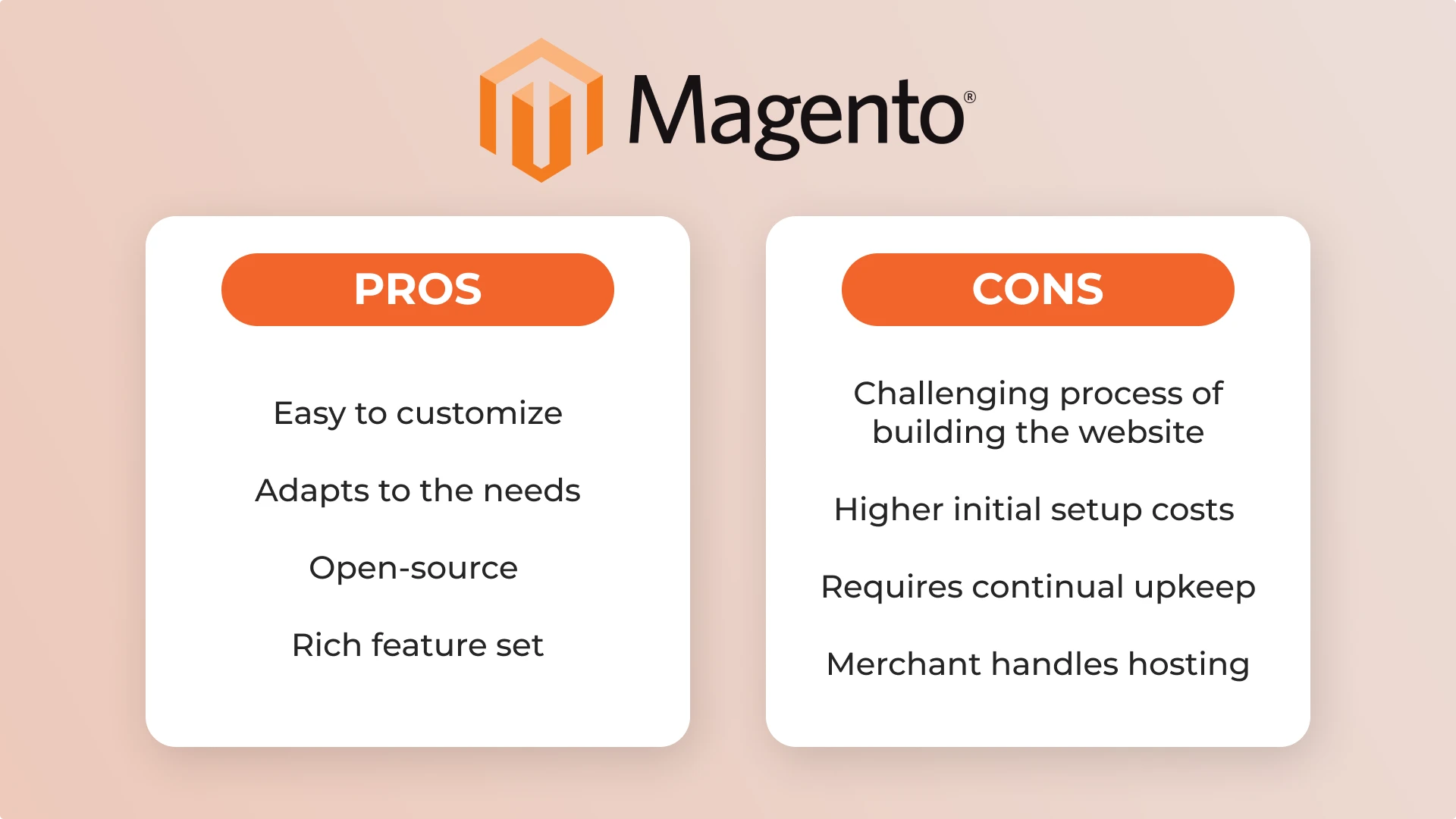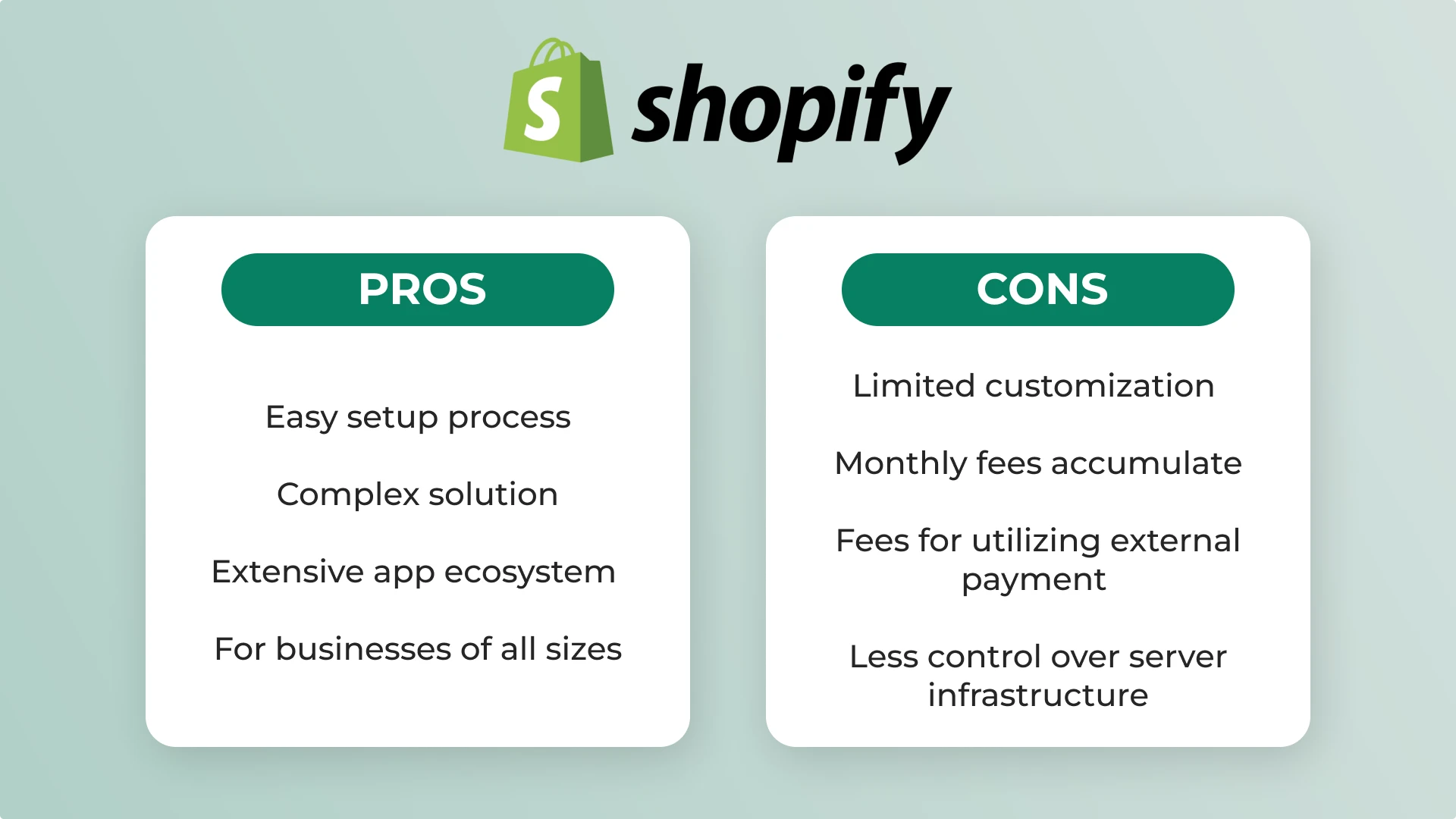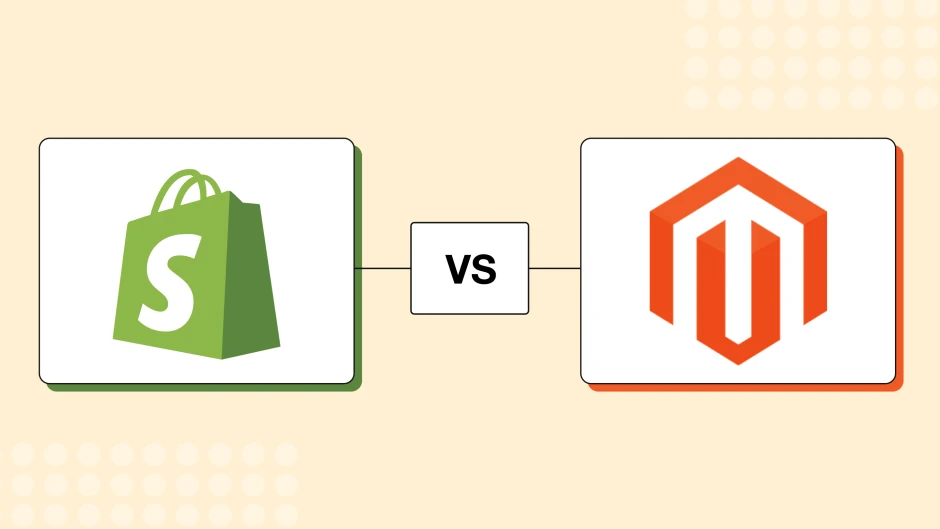Shopify vs Magento: Key Differences & Features Compared in 2024
-
 Oleksandra Petrenko
Oleksandra Petrenko
- Magento 2
- 7 min read
In the fast-paced realm of digital sales, a reliable base to launch your digital storefront is a cornerstone of success. Whether you choose Magento or Shopify to build your website, these two digital commerce leaders have distinct advantages and challenges. As we venture further into 2024, understanding the fundamental perks and limitations of each alternative becomes increasingly crucial. In this guide, we will summarize a comparison of Magento vs Shopify, exploring their benefits and drawbacks.
Magento vs Shopify: A Detailed Comparison
Magento and Shopify are platforms for establishing and operating your digital storefront. They present enormous possibilities to tweak and adjust your webstores, ascertain an effortless ordering process, manage the supply chain and logistics, and accept payments through different channels.
Magento (part of Adobe Commerce), is an open-source solution that contributes to virtually infinite opportunities for establishing your storefront. Its rich toolset comprises procurement and stock monitoring, solid SEO tools, multi-store management, and powerful marketing functionalities. Plus, there are numerous extensions and design themes available to suit your particular requirements or high-growth ambitions. Nevertheless, employing a tech expert is required for crafting and operating your webstore to leverage its features and opportunities to a full extent.
Shopify is a cloud-based multipurpose powerful toolbox for building digital shops. Shopify lets you effortlessly launch and individualize your project with pre-made templates, manage goods in stock, process orders securely, and implement distinct marketing strategies. Shopify compared to Magento is famous for its clarity and streamlined UX, so you will not need any additional tech expertise or development resources. This CMS has various subscription tariffs, with tiers for both humble shops and larger companies. Moreover, Shopify possesses a broad assortment of applications and extensions to further enhance its functionality.
Overview of Magento

Brief History and Background
Magento, founded in 2008, quickly rose to prominence as a major e-commerce platform. Created by Varien Inc., it became an independent company in 2015 after its acquirement by eBay Inc. and subsequently Adobe in 2018. Magento's story began with its open-source Community Edition, offering a remarkably customizable CMS. Later it grew to include Magento Enterprise, with extra capabilities for major corporations. Today, Magento stays among the leaders of the digital sales market, empowering companies of various sizes with its dynamic potential and individualization opportunities.
Key Features and Capabilities
Magento has numerous components that facilitate the launch and operations of shopping websites. Its rich inventory organization functionalities allow adding, editing, and managing goods, incorporating customizable and digital items. This CMS has robust SEO functionalities to expand the brand’s digital presence. Furthermore, Magento provides multi-store functionality to manage different stores from one dashboard, which works great for brands with various product lines or international operations. Besides, you can set various pricing and promotion tiers, secure checkouts, and powerful advertising tools like individualized ads and client segmenting.
Target Audience and Market Share
Magento provides powerful resources for companies from small startups to large enterprises, in different industries. Magento's target audience includes retailers, wholesalers, and manufacturers looking to establish a solid online presence. Regarding market share, Magento holds a leading position in the e-commerce landscape, particularly among mid-market and enterprise-level businesses. While exact market share figures vary, Magento and Shopify consistently rank in the top platforms globally, along with other leading players like WooCommerce and BigCommerce.
Overview of Shopify

Brief History and Background
Shopify was founded in 2006 in Canada. It appeared as a response to the creators' dissatisfaction with the digital commerce options presented at that moment. Originally an online snowboard shop, Shopify quickly pivoted into a powerful CMS platform. Shopify has experienced rapid growth and success, going public in 2015 and emerging as a leading e-commerce base globally. Today, Shopify along with Magento serves millions of sellers worldwide, offering an all-in-one solution for selling online.
Key Features and Capabilities
Shopify makes establishing and operating online shops super easy with its set of services and tools. Its simple user experience streamlines the launching and adjusting of your website without any software development skills. Shopify has a wide scope of templates with customizable designs. Moreover, store owners receive catalog tools to add, alter, and organize products, manage inventory, and carry out orders efficiently. This platform provides a streamlined checkout process, that supports multiple forms of transactions and has advertisement and SEO features to engage with clients.
Target Audience and Market Share
Shopify’s smooth user experience and accessible setup tempt entrepreneurs to swiftly establish their shop. As for the market share, Shopify holds a strong position, with an increasing presence in B2B and B2C transactions. Its comprehensive feature set made Shopify extremely popular and successful in the global market.
Comparison of Shopify vs Magento
Price Considerations
Shopify delivers a complete solution with a clear pricing structure. It has monthly license fees to fit any budget. These plans typically cover hosting, security, and support, so that entrepreneurs can plan their spending with no hassle.
As for Magento, its total cost depends on elements such as hosting, development, and upkeep costs. Magento unlike Shopify, delivers free open-source code to establish your website, but be ready to spend extra bucks on hosting, installing extensions, and adding customization. Shopify is presumed to be cost-effective for small projects or those with limited budgeting, while Magento may offer better value for bigger enterprises with intricate needs.
Configurations
Magento provides you with numerous ways to individualize your webstore and meet almost any special commercial need. Also, it caters to a great variety of add-ons, to customize virtually every detail of the store, from unique designs to backend processes.
Shopify also has features for adapting your website design but to a smaller extent compared to Magento. While Shopify has numerous pre-designed templates and themes for customization, they may not fit all the complex branding requirements.
User-Friendliness of Magento vs Shopify
Shopify excels with its rational interface and unseamed user interaction. Shopify's administration is straightforward, so you can set up your website effortlessly. You will not need to employ tech experts or a development team, so it can become a lifesaver for shops with limited budgeting.
Magento has a more complicated setup process, especially if you have little tech skills. While Magento gives you access to free open-source code, launching your shop may demand additional time, effort, and tech expertise or assistance from developers.
Scalability and Performance
Both Magento and Shopify are very adaptable to scale your operations at different stages of your enterprise growth. Nevertheless, Magento seems to be tailored to the requirements of expansive corporations better. Its framework and modular structure can easily manage high volumes of traffic or intricate product catalogs.
Shopify’s scalability options, however, fit small-scale enterprises with more straightforward needs. Performance-wise, both CMSs have rich performance optimization tools to guarantee a seamless and effective client experience.
Integrations and Extensions
While using both Magento and Shopify you can add integrations and applications to broaden essential tools and enrich your website abilities. Magento's marketplace offers numerous extensions and integrations from external suppliers or independent developers, offering extra functions for everything from payment options and logistics to advertisement and client support.
Shopify likewise has lots of distinct applications in the Shopify App Store. Regardless if you need services for promo campaigns, stock operations, or analytics, both Magento and Shopify can connect with widely used external services and add-ons.
Client Support
Both Magento and Shopify have vast assistance for store owners and administrators. Shopify includes 24/7 customer support via phone, email, and live chat, alongside comprehensive instructions and how-to articles to get rolling and resolve any troubles you may face.
Magento, meanwhile, has support options in every edition, including community forums, documentation, and premium support services for Magento Commerce clients. Moreover, both platforms benefit from active developer communities, online forums, and user groups, where you can seek guidance, exchange insights, and engage in collaboration with fellow platform users.
Pros and Cons Magento vs Shopify

Advantages of Magento:
- Easy to adjust and individualize;
- Adapts to the requests of larger companies;
- Open-source architecture ensures full control and ownership;
- Rich toolset for operating webstores and incorporating external add-ons.
Disadvantages of Magento:
- More challenging process of building the website, particularly for non-tech users;
- Higher initial setup and operational costs;
- Needs continual upkeep and enhancements for ensuring safety and peak performance;
- Hosting and infrastructure management responsibilities fall on the store owner.

Advantages of Shopify:
- Easy to launch your store;
- All-in-one solution with hosting, security, and support;
- Extensive app ecosystem for extending features and personalization;
- Easy to expand to various scales, ranging from small businesses to large corporations.
Disadvantages of Shopify:
- Limited customization than Magento;
- Monthly license fees add up over time and may become expensive for larger enterprises;
- Fees for utilizing external payment processing services on lower-tier plans;
- Less control over server infrastructure and backend processes.
What to choose in the end: Magento 2 vs Shopify Plus
To conclude, Magento and Shopify are two leading solutions that can be tailored to specific needs and preferences within the online sales domain. Magento delivers extensive personalization opportunities along with the ability to scale and accommodate complex demands. But there is a catch: you might need to employ a tech expert to your team to utilize it effectively.
Conversely, Shopify provides a simple and trouble-free experience, remaining a prime preference for small businesses to quickly launch and expand their online shops without employing extra tech resources. In the long run, a decision between Magento and Shopify relies on each company’s context such as scale and industry, technical capabilities, and long-term growth objectives.




